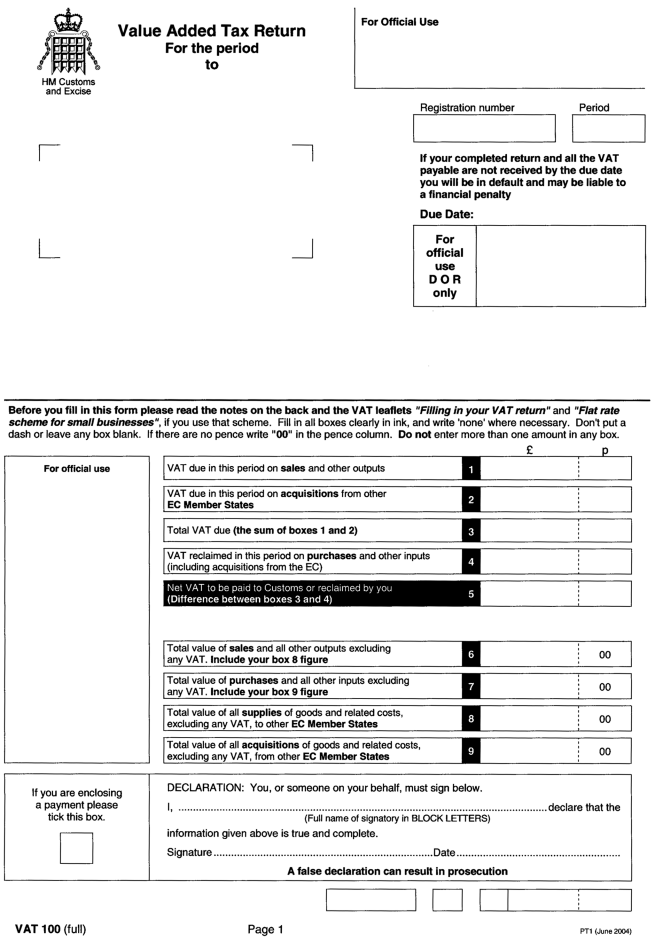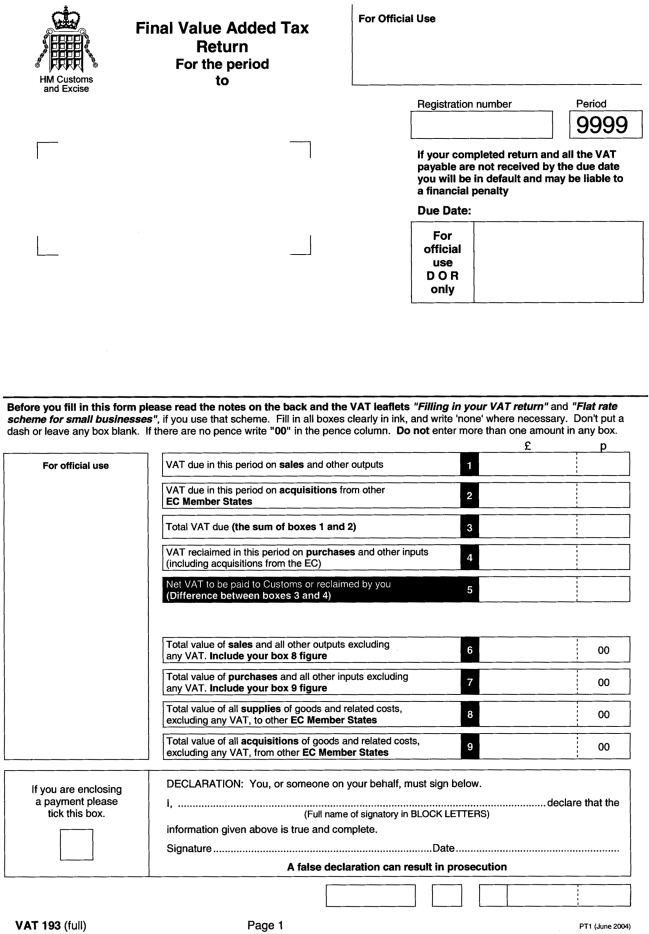- Y Diweddaraf sydd Ar Gael (Diwygiedig)
- Gwreiddiol (a wnaed Fel)
The Value Added Tax (Amendment) (No. 3) Regulations 2004
You are here:
- Offerynnau Statudol y Deyrnas Unedig
- 2004 No. 1675
- Whole Instrument
- Blaenorol
- Nesaf
Rhagor o Adnoddau
Status:
Dyma’r fersiwn wreiddiol (fel y’i gwnaed yn wreiddiol). This item of legislation is currently only available in its original format.
Statutory Instruments
2004 No. 1675
VALUE ADDED TAX
The Value Added Tax (Amendment) (No. 3) Regulations 2004
Made
1st July 2004
Laid before the House of Commons
1st July 2004
Coming into force
22nd July 2004
The Commissioners of Customs and Excise, in exercise of the powers conferred on them by sections 3(2), 3(4), 25(1), 49(2), 49(3) and 58 of and Schedule 1 paragraph 17, Schedule 2 paragraph 9, Schedule 3 paragraph 10, Schedule 3A paragraph 8 and Schedule 11 paragraphs 2(1), 2(11) and 7(1) to the Value Added Tax Act 1994(1), sections 133(1), 133(2) and 133(5) of the Finance Act 1999(2), and section 143(1) of and Schedule 38 paragraphs 1(1), 1(2), 2(1), 2(2), 3(1), 3(2), 3(3), 4(1), 4(2), 4(3), 5 and 7(1) to the Finance Act 2000(3), hereby make the following regulations:
1.—(1) These Regulations may be cited as the Value Added Tax (Amendment) (No. 3) Regulations 2004 and come into force on 22nd July 2004.
(2) The Value Added Tax (Electronic Communications) (Incentives) Regulations 2001(4) are revoked (incentive for making VAT return by way of electronic return system).
(3) The Value Added Tax Regulations 1995(5) are amended as follows.
Electronic registration, etc.
2.—(1) In regulation 5(1), for “or 6(1)” substitute “, 6(1) or 7(1)”.
(2) After regulation 5(3), insert—
“(4) A notification subject to or required by paragraph (1), (2) or (3) may be made instead using an electronic communications system that remains specified for the purpose in a current general direction given by the Commissioners.
A system specified for a purpose of paragraph (1) may modify or dispense with any particular required for that purpose by that paragraph.
(5) The time a notification is made using such a system corresponds to when a fully mechanised feature of that system generates a relevant acknowledgement.
(6) If such a feature does not generate an acknowledgement, but would do so in the circumstances alleged, a relevant notification is not made using that system in those alleged circumstances.
(7) Paragraphs (5) and (6) apply as conclusive presumptions.
(8) Paragraph (4) only applies to a notification that is envisaged by a current direction.
(9) Paragraph (4) does not apply at a notification’s deadline if the system specified for that notification is not then functioning.
A notification’s deadline is the latest time by which it is required to be made.
(10) The Commissioners need not give a general direction pursuant to paragraph (4).
(11) Any general direction under paragraph (4) must specify both the form of an electronic communications system and the sole circumstances in which it may be used, and may specify different forms or circumstances for different cases.
(12) A system need not include a feature of the type envisaged by paragraph (5) or (6).
(13) A direction is not current for the purposes of paragraphs (4) and (8) to the extent that it is varied, replaced or revoked by another Commissioners' direction.
(14) A notification made under paragraph (4) carries the same consequences as a notification under paragraph (1), (2) or (3) (as appropriate), except in relation to any matter for which alternative or additional provision is made by or under paragraphs (4) to (7).”.
Transfers of going concerns
3. In regulation 6(3)(a), for “41” substitute “40”.
Electronic returns, etc. and electronic payments
4.—(1) In regulation 25(4A), omit the expression “on an electronic version of Form 4 or Form 5 (as appropriate)”.
(2) For regulation 25(4D), substitute—
“(4D) A direction under paragraph (4C)(a) may in particular—
(a)modify or dispense with any requirement of Form 4 or Form 5 (as appropriate);
(b)specify circumstances in which the electronic return system may be used, or not used, by or on behalf of the person required to make the return.
For the purposes of sub-paragraph (b), the direction may specify different circumstances for different cases.”.
(3) In regulation 25(4F), for “(4D) above” substitute “(4J) below”.
(4) In regulation 25(4F)(c), for “making” substitute “delivering”.
(5) For regulations 25(4J) to 25(4L), substitute—
“(4J) No return shall be treated as having been made using an electronic return system unless the conditions imposed by paragraph (4C) are satisfied.
The condition in paragraph (4C)(a) incorporates the matters mentioned in paragraph (4D).
(4K) A return made using an electronic return system carries the same consequences as a return made on Form 4 or Form 5 (as appropriate), except in relation to any matter for which alternative or additional provision is made by or under paragraphs (4C) to (4F).
(4L) Additional time is allowed to make a return for which any related payment is made solely by means of electronic communications (see paragraph (1) – time for making return, and regulations 40(2) to 40(4) – payment of VAT).
That additional time is only as the Commissioners may allow in a specific or general direction, and such a direction may allow different times for different means of payment.
The Commissioners need not give a direction pursuant to this paragraph.
(4M) In paragraphs (4C) and (4L) “direction” refers only to a current direction, and a direction is not current to the extent that it is varied, replaced or revoked by another Commissioners' direction.”.
5. After regulation 40(3), insert—
“(4) A direction under paragraph (3) may in particular allow additional time for a payment mentioned in paragraph (2) that is made by means of electronic communications.
The direction may allow different times for different means of payment.
(5) Later payment so allowed does not of itself constitute a default for the purposes of section 59 of the Act (default surcharge).”.
Standard returns
6.—(1) For “Form No 4: VAT Return” in Schedule 1, substitute form 1 in the Schedule to these Regulations.
(2) For “Form No 5: Final VAT Return” in Schedule 1, substitute form 2 in the Schedule to these Regulations.
Michael Hanson
Commissioner of Customs and Excise
New King’s Beam House 22 Upper Ground London SE1 9PJ
1st July 2004
Regulation 6
SCHEDULE
Explanatory Note
(This note is not part of the Regulations)
Regulation 1(2) revokes the Value Added Tax (Electronic Communications) (Incentives) Regulations 2001 (S.I. 2001/759)(6).
Regulation 1(3) and the subsequent regulations amend the Value Added Tax Regulations 1995 (S.I. 1995/2518)(7).
Regulations 2 and 3 – VAT registration and register
Regulation 2(2) enables businesses to notify VAT registrability or VAT register information using functioning electronic communication systems specified by HM Customs and Excise. Mechanised acknowledgements forming part of a system are conclusive as to whether or when a notification is made using that system. Electronic notifications otherwise carry the ordinary consequences.
Regulation 2(1) aligns the registrability notification procedure for transferees of a going concern with the practice for other registrability notifications. Regulation 3 makes a typographical correction relating to liabilities following a transfer of a going concern.
Regulations 4, 5 and 6 - VAT returns and payment
Regulations 4(1) and 4(2) remove the requirement for an electronic VAT return system to mirror the paper forms. Regulation 4(2) also enables HM Customs and Excise to specify the circumstances in which a business may arrange for an intermediary to deliver an electronic return.
Regulations 4(5) and 5 enable HM Customs and Excise to allow extra time for paying VAT due, and for making VAT returns, depending on the electronic means of payment used.(8)
Regulation 6 substitutes new standard paper VAT returns.
Regulatory impact assessment
A full regulatory impact assessment of the effect that this instrument will have on the costs of businesses, charities or voluntary bodies is available from HM Customs and Excise, New King’s Beam House, 22 Upper Ground, London SE1 9PJ or http://www.hmce.gov.uk .
1994 c. 23; section 96(1) provides that “the Commissioners” means the Commissioners of Customs and Excise and that “regulations” means regulations made by the Commissioners under the Act. Schedule 3A was inserted by the Finance Act 2000 (c. 17) section 136(8) and Schedule 36.
S.I. 2001/759.
Regulations about incentive payment for making VAT returns by way of an electronic return system.
Implementing, in part, Articles 22.1, 22.4 and 22.5 of the Sixth Council Directive of 17th May 1977 on the harmonisation of the laws of the Member States relating to turnover taxes – common system of value added tax: uniform basis of assessment (OJ No L 145, 13.6.77, p 1) (including the relevant amendments made by Article 2 of Council Directive 2002/38/EC of 7th May 2002 (OJ No L 128, 15.5.02, p 41)). A transposition note is available from HM Customs and Excise, New King’s Beam House, 22 Upper Ground, London SE1 9PJ or http://www.hmce.gov.uk .
Regulations 4(3), 4(4) and 4(5) make or also make consequential changes.
Options/Help
Print Options
PrintThe Whole Instrument
Mae deddfwriaeth ar gael mewn fersiynau gwahanol:
Y Diweddaraf sydd Ar Gael (diwygiedig):Y fersiwn ddiweddaraf sydd ar gael o’r ddeddfwriaeth yn cynnwys newidiadau a wnaed gan ddeddfwriaeth ddilynol ac wedi eu gweithredu gan ein tîm golygyddol. Gellir gweld y newidiadau nad ydym wedi eu gweithredu i’r testun eto yn yr ardal ‘Newidiadau i Ddeddfwriaeth’.
Gwreiddiol (Fel y’i Deddfwyd neu y’i Gwnaed): Mae'r wreiddiol fersiwn y ddeddfwriaeth fel ag yr oedd pan gafodd ei deddfu neu eu gwneud. Ni wnaed unrhyw newidiadau i’r testun.
Memorandwm Esboniadol
Mae Memoranda Esboniadol yn nodi datganiad byr o ddiben Offeryn Statudol ac yn rhoi gwybodaeth am ei amcan polisi a goblygiadau polisi. Maent yn ceisio gwneud yr Offeryn Statudol yn hygyrch i ddarllenwyr nad oes ganddynt gymhwyster cyfreithiol, ac maent yn cyd-fynd ag unrhyw Offeryn Statudol neu Offeryn Statudol Drafft a gyflwynwyd ger bron y Senedd o Fehefin 2004 ymlaen.
Rhagor o Adnoddau
Gallwch wneud defnydd o ddogfennau atodol hanfodol a gwybodaeth ar gyfer yr eitem ddeddfwriaeth o’r tab hwn. Yn ddibynnol ar yr eitem ddeddfwriaeth sydd i’w gweld, gallai hyn gynnwys:
- y PDF print gwreiddiol y fel deddfwyd fersiwn a ddefnyddiwyd am y copi print
- rhestr o newidiadau a wnaed gan a/neu yn effeithio ar yr eitem hon o ddeddfwriaeth
- manylion rhoi grym a newid cyffredinol
- pob fformat o’r holl ddogfennau cysylltiedig
- slipiau cywiro
- dolenni i ddeddfwriaeth gysylltiedig ac adnoddau gwybodaeth eraill
Rhagor o Adnoddau
Defnyddiwch y ddewislen hon i agor dogfennau hanfodol sy’n cyd-fynd â’r ddeddfwriaeth a gwybodaeth am yr eitem hon o ddeddfwriaeth. Gan ddibynnu ar yr eitem o ddeddfwriaeth sy’n cael ei gweld gall hyn gynnwys:
- y PDF print gwreiddiol y fel gwnaed fersiwn a ddefnyddiwyd am y copi print
- slipiau cywiro
liciwch ‘Gweld Mwy’ neu ddewis ‘Rhagor o Adnoddau’ am wybodaeth ychwanegol gan gynnwys
- rhestr o newidiadau a wnaed gan a/neu yn effeithio ar yr eitem hon o ddeddfwriaeth
- manylion rhoi grym a newid cyffredinol
- pob fformat o’r holl ddogfennau cysylltiedig
- dolenni i ddeddfwriaeth gysylltiedig ac adnoddau gwybodaeth eraill


